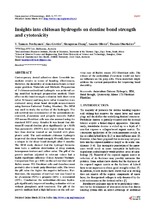| dc.contributor.author | Perchyonok, Tamara | |
| dc.contributor.author | Grobler, Sias Renier | |
| dc.contributor.author | Zhang, Shengmiao | |
| dc.contributor.author | Olivier, Annette | |
| dc.contributor.author | Oberholzer, Theunis | |
| dc.date.accessioned | 2014-07-04T13:57:14Z | |
| dc.date.available | 2014-07-04T13:57:14Z | |
| dc.date.issued | 2013 | |
| dc.identifier.citation | Perchyonok, V. T., et al. (2013). Insights into chitosan hydrogels on dentine bond strength and cytotoxicity. Open Journal of Stomatology, 3(1):75-82 | en_US |
| dc.identifier.issn | 2160-8709 | |
| dc.identifier.uri | http://hdl.handle.net/10566/1121 | |
| dc.description.abstract | Contemporary dental adhesives show favorable im- mediate results in terms of bonding effectiveness. However, the durability of resin-dentin bonds is their major problem. Materials and Methods: Preparation of 3 chitosan-antioxidant hydrogels was achieved us- ing modified hydrogel preparation method. Their effect on the bond strength to dentine both short term (after 24 hours) and long term (after 6 months) were evaluated using shear bond strength measurements using Instron Universal Testing Mascine). The SEM was used to study the surface of the hydrogels. The cell survival rate (cytotoxicity) of the antioxidants re- sveratrol, β-carotene and propolis towards Balb/c 3T3 mouse fibroblast cells was also assessed using the standard MTT assay. Results: It was found that chi- tosan-H treated dentine gives significantly (p < 0.05; Non-parametric ANOVA test) higher shear bond va- lues than dentine treated or not treated with phos- phoric acid. The anti-oxidants chitosan hydrogels improved the shear bond strength. Overall, there was a relapse in the shear bond strength after 6 months. The SEM study showed that the hydrogel formula- tions have a uniform distribution of drug content, homogenous texture and yellow color. The pH of the growth medium adjusted to relevant values had a highly significant influence (Tukey-Kramer Multiple- Comparison Test; p < 0.01) on the cell survival rate of Balb/c mouse 3T3 fibroblast cells and therefore most probably also to tooth pulp fibroblast cells. The lower the pH value the higher the negative influence. Fur- thermore, the sequence of survival rate was found to be: β-carotene (92%) > propolis (68%) > resveratrol (33%). Conclusion: the antioxidant-chitosan hydro- gels significantly improved bonding to dentine with or without phosphoric acid treatment. The pH of the growth medium had a high influence on the cell survival rate of Balb/c mouse 3T3 fibroblast cells. The release of the antioxidant β-carotene would not have an influence on the pulp cells. These materials might address the current perspectives for improving bond durability. | en_US |
| dc.description.sponsorship | DDF fund of the South African Dental Association; School of Dentistry and Oral Health, Griffith University | en_US |
| dc.language.iso | en | en_US |
| dc.publisher | Scientific Research Publishing | en_US |
| dc.rights | Copyright Scientific Research Publishing. This item may be freely used provided that acknowledgment of the source is provided. No commercial use may be made without permission of the author. | |
| dc.source.uri | http://dx.doi.org/10.4236/ojst.2013.31014 | |
| dc.source.uri | http://www.scirp.org/journal/ojst/ | |
| dc.subject | Antioxidant-Chitosan hydrogels | en_US |
| dc.subject | SEM | en_US |
| dc.subject | Bond strength | en_US |
| dc.subject | Cytotoxicity | en_US |
| dc.subject | Mouse 3T3 fibroblast | en_US |
| dc.title | Insights into chitosan hydrogels on dentine bond strength and cytotoxicity | en_US |
| dc.type | Article | en_US |
| dc.privacy.showsubmitter | false | |
| dc.status.ispeerreviewed | true | |
| dc.description.accreditation | Web of Science | en_US |

